
Anthemis : planting and care
Contents
Anthémis, in a nutshell
- Anthémis are perennial plants, biennial or annual, with rapid growth.
- From late spring to summer, they display numerous daisy-like flowers in white, cream, pink, yellow or orange, with a large, often contrasting central disc, which cover finely divided foliage of a more or less silvery green.
- These undemanding plants, short-lived but very easy to grow, enjoy full sun, well-drained soils and are most effective in rockeries, in containers or in a border.
A word from our expert
Genus Anthemis offers attractive hardy plants for summer containers, sunny borders or rockeries, all originating from Mediterranean Basin or Asia Minor. Flowering in the form of heads, as with daisy, is generally profuse when conditions are right. Wild species usually produce vivid colours — white with yellow centre, golden yellow or orange — while horticultural forms often show softer shades easier to combine, cream in Anthemis Sauce Hollandaise, lemon yellow in Kelway’s Variety, etc.
Plant Anthemis in dry, poor, gravelly soil and a sunny position! With rapid growth, they will reward you with a long and generous flowering starting in May or June and lasting 2 to 4 months depending on species.
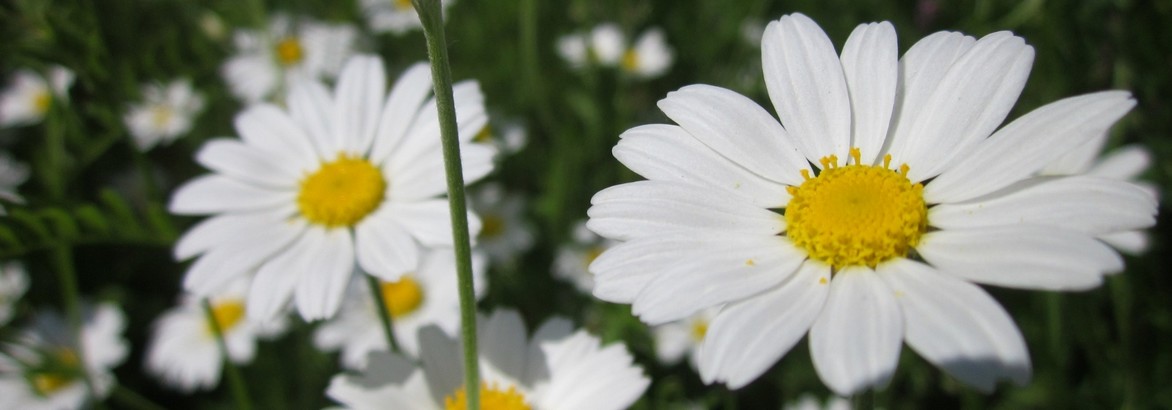
Most vigorous forms make clumps 40 to 70 cm across and are well suited to borders or to plant against a low wall (Anthemis tinctoria, sancti-johannis, hybrids) while compact, spreading-habit species such as Anthemis cretica, cupaniana, marschalliana are ideal in rockeries or for edging.
True sun-lovers par excellence, Anthemis are undemanding about soil quality and most of all dislike excess winter moisture. Plant in ordinary, well-drained soil, slightly acidic to neutral or calcareous. Their lifespan is shorter and their frost tolerance lower in heavy soil than in poor, dry soil. These species are hardy to very hardy, as with dyer’s chamomile (Anthemis tinctoria) which tolerates down to -30°C. Maintenance consists only of cutting back clumps after flowering to encourage new shoots and promote a re-flowering in autumn. This helps plants cope better with a rainy winter. The operation also produces an attractive rosette of leaves in winter and can extend plant life, which sometimes lasts only a single season.
Description and botany
Botanical data
- Latin name Anthemis
- Family Asteraceae
- Common name St John's anthémis, camomile or dyer's cota, false chamomile
- Flowering between May and September
- Height between 0.15 and 1 m
- Exposure sun
- Soil type any well-drained soil, even calcareous
- Hardiness Good to excellent (-15 to -34 °C)
Les Anthemis appartiennent à la famille des Astéracées. Le genre Anthemis compte aujourd’hui près de deux cents espèces d’annuelles et de vivaces originaires du Bassin Méditerranéen et d’Asie Mineure, mais dont l’aire de répartition s’étend jusqu’au sud de la Scandinavie. L’Anthemis des teinturiers s’est par exemple naturalisée en Grande-Bretagne et aux Etats-Unis. Elles fleurissent généreusement en fin de printemps et été. Il me paraît nécessaire de donner quelques détails de nomenclature pour bien préciser les plantes dont traite cet article : Les espèces proposées sous ce nom de genre sont très rustiques comme Anthemis tinctoria, encore appelé Camomille des teinturiers, résistante à -30°C et sont caduques ou persistantes. Les espèces originaires des Canaries et Madère, peu rustiques et proposées comme sous-arbrisseau annuel font désormais partie du genre Argyranthemum même si on continue de les nommer Anthémis ou Arbre à marguerite en langage courant. Elles ont aussi porté le nom de Chrysanthemum frutescens et Pyrethrum frutescens. Les vraies Anthemis sont nommées communément sous des noms tels que “Camomille des teinturiers” (A. tinctoria), “fausse camomille” sachant que la vraie camomille consommée sous forme de tisane est incluse désormais dans le genre Chamaemelum.
Anthemis are perennials with a spreading, ramified habit that in some species becomes rather untidy with age, while certain species adopt a compact cushion habit. Vegetation is evergreen or deciduous. The aromatic foliage, with a strong odour considered unpleasant in Anthemis cotula, is alternate, single but finely dissected (pinnatisect), sometimes tomentose which gives a silvery hue and improved drought tolerance.
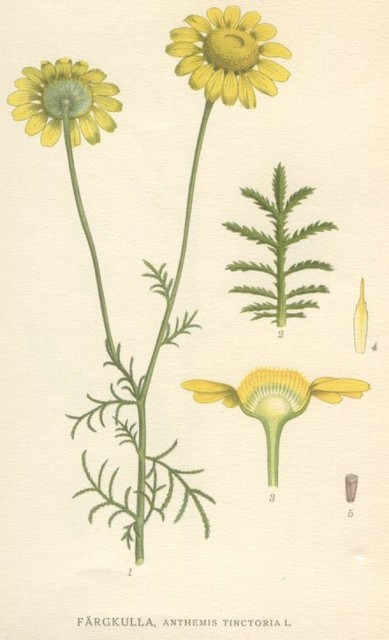
Anthemis tinctoria – botanical illustration
L’anthémis de la Saint-Jean (A. sancti-johannis) forme ainsi une touffe buissonnante à port lâche muni d’un feuillage plumeux vert foncé teinté de gris. Anthemis cupaniana possède un feuillage feutré, plus ou moins gris, évoquant celui d’une armoise et forme de gros coussins compacts atteignant 60 cm de diamètre sur 20 à 30 de haut.
La floraison des Anthemis est une inflorescence sous forme de capitule de taille moyenne (2 à 4 cm chez Anthemis tinctoria), rattaché à la tige par un long pédoncule, généralement blanc, crème, jaune voire orangé (A. sancti-johannis), au disque central souvent large et contrasté comme chez Anthemis ‘Moonlight’. Les fleurs ligulaires rayonnantes, évoquant des pétales terminés par 3 petites dents, sont des fleurs femelles qui attirent les insectes pollinisateurs et leur servent de piste d’atterrissage. Les fleurs tubulaires du cœur du capitule sont hermaphrodites et présentent 1 pistil et 5 étamines. Elles se transforment après pollinisation par les insectes, en akène sans aigrette, de 2 à 4 mm de long.
Les fleurs d’Anthemis, notamment chez les hybrides, conviennent bien pour réaliser des bouquets. Elles sont très nectarifères et attirent à la fois les abeilles et les papillons.
L’Anthemis des teinturiers, appelée aussi Cota des teinturiers, servait à produire une teinture jaune. Présente en basse altitude entre 0 et 1600 m depuis la France jusqu’en Turquie, ainsi que dans le Caucase et en Iran, elle s’est aujourd’hui largement naturalisée en Amérique du Nord.
Le nom Anthemis vient du grec anthemon qui signifie “fleuri”.
Read also
Care of perennial plantsMain varieties of Anthemis
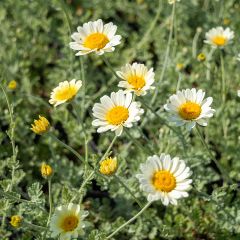
Anthemis tinctoria Sauce Hollandaise - Marguerite
- Flowering time July to October
- Height at maturity 50 cm

Anthemis tinctoria E.C. Buxton - Marguerite
- Flowering time July to September
- Height at maturity 60 cm
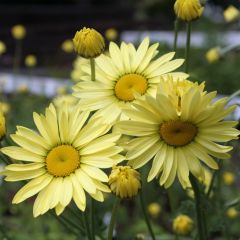
Anthemis tinctoria Wargrave Variety - Marguerite
- Flowering time July to September
- Height at maturity 70 cm
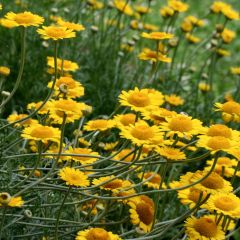
Anthemis tinctoria Kelwayi - Marguerite
- Flowering time June to October
- Height at maturity 70 cm
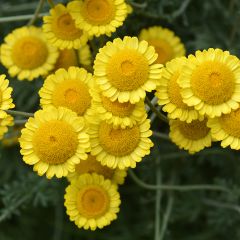
Anthemis sancti-johannis
- Flowering time August to October
- Height at maturity 50 cm
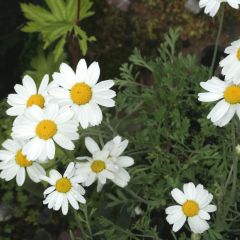
Anthemis carpatica Karpatenschnee - Marguerite
- Flowering time June to September
- Height at maturity 15 cm
Discover other Anthemis
View all →Available in 2 sizes
Available in 2 sizes
Available in 2 sizes
Available in 1 sizes
Available in 1 sizes
Available in 1 sizes
Available in 1 sizes
Available in 1 sizes
Planting
Where to plant Anthemis?
Use a bank or rockery receiving more than 6 hours’ sun a day, in well-drained soil to plant Anthemis. Slightly acidic, neutral or calcareous soil suits Anthemis perfectly. Thorough sun-lovers, Anthemis most of all dread excess moisture in winter, which shortens their lifespan. Their frost hardiness is greater when soil is dry. In shade, Anthemis rarely survive more than two years.
When to plant?
Plant preferably in September or March–April.
How to plant?
This plant is very easy for beginners, even on gravelly, poor, dry soil.
- Dip the bucket into a pail of water to moisten it thoroughly.
- Dig a hole three times wider than the rootball and loosen the soil around it with the prongs of a digging fork.
- Add a few handfuls of sand and gravel to ensure good drainage around the roots. In heavy soil, opt for planting on a mound or in a rockery.
- Add half a spadeful of potting compost or well-rotted compost if soil is very poor. Anthemis tinctoria likes good garden soil to flower for a long time but loses vigour after about two years, so it is preferable to replace the plant, as with snapdragons or sweet William.
- Place the plant in the planting hole.
- Replace soil and firm lightly.
- Water deeply.
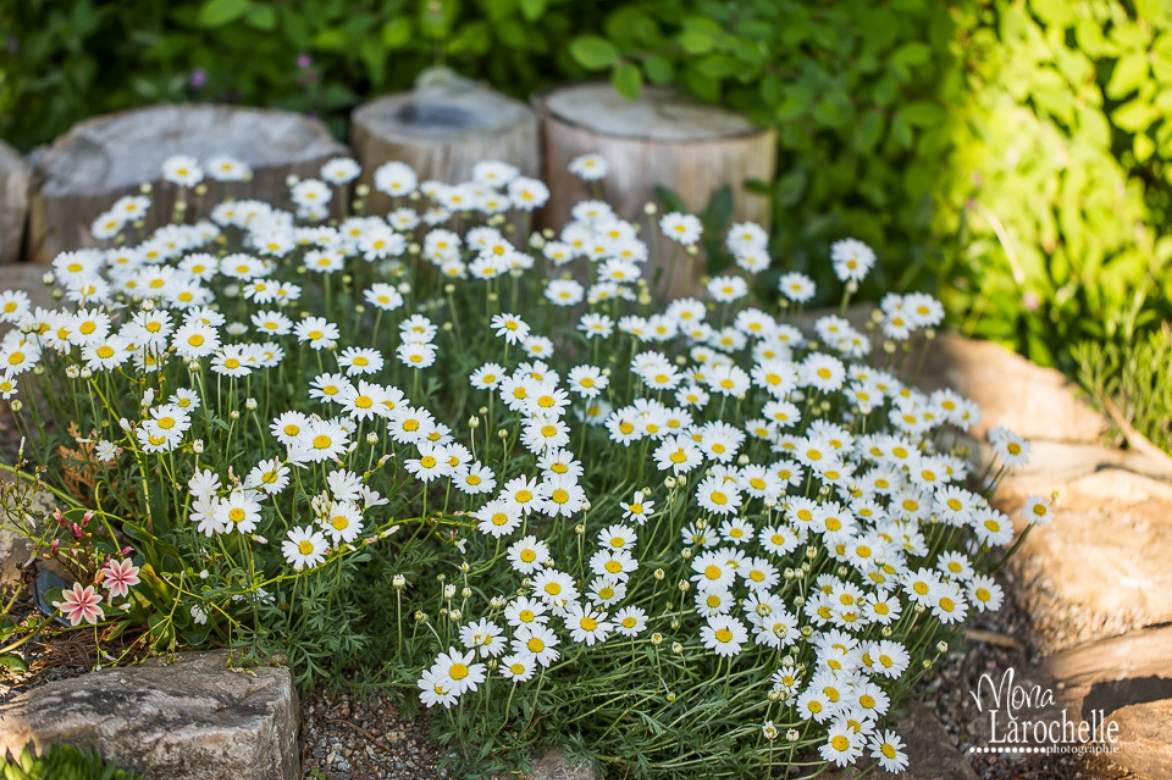
Clump of Anthemis carpatica ‘Karpatenschnee’ in rockery
Caring for Anthemis
- Pinch out tips of shoots when they reach 20 cm in height to encourage a bushier plant.
- Water regularly during first year to encourage good establishment of young plant.
- Then simply give a shear cut at about 20 cm above soil level at end of flowering. Do not wait beyond early September so that clump can heal well and regenerate by end of season. Slight flowering may sometimes occur in autumn.
- Leave some stems to set seed to ensure plant’s progeny.
- Lightly fork soil around to weed and add a spadeful of compost in spring.
- Anthemis are sometimes attacked by aphids. Simply crush a few infested stems and leave rest for hoverflies and ladybirds, which will feast on them.
Multiplication
Simplest propagation involves dividing the clump in spring or autumn for Anthemis cupaniana or taking stem cuttings during summer months, particularly for Anthemis tinctoria.
Propagation by cuttings
Prepare a deep pot by filling it with potting compost mixed with sand.
- Take shoot tips about 10 cm long.
- Remove leaves near base of cutting.
- Insert them two-thirds of their length, ensuring they do not touch each other.
- Firm soil gently all round to remove air pockets and ensure good contact between potting compost and cutting.
- Place them under cover in a bright spot.
- In autumn, separate rooted cuttings and plant them in buckets which you keep under a cold frame until spring.
- Plant young plants in open ground in spring.
Clump division
Clear soil from around roots with a hand fork, then drive a sharp spade into centre of clump to separate off divisions.
Uses and companion planting
With their rustic charm and low requirements, do not hesitate to use Anthemis to quickly flower poor soil, particularly after construction machinery has passed. They are pioneer plants that settle easily in open areas, on fallow land or within dry prairies, associated with drought-tolerant plants such as common sage, borage, poppies, cornflowers, snapdragons, wallflowers… They can be very useful for starting a brand-new garden. Anthemis fits equally well into cottage-style borders, more formal flowerbeds, rockeries or as an edging plant, and even in a cut-flower garden.
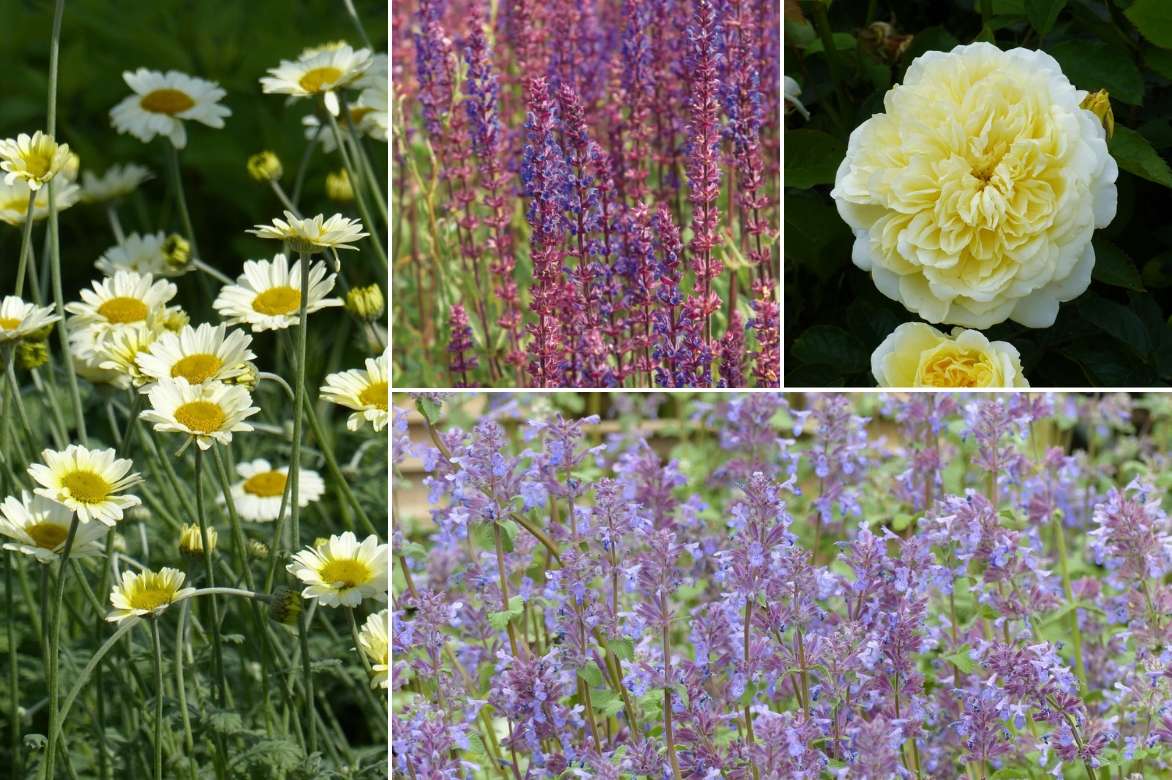
A planting idea for a sunny border: Anthemis tinctoria ‘Sauce Hollandaise’, Salvia nemorosa ‘Caradonna’, rose ‘The Pilgrim’ and Nepeta faassenii ‘Six Hills Giant’
Their foliage combines well with grey-leaved plants such as Artemisia, santolina, Nepeta or lavender, as well as with old roses.
To create a vibrant scene, pair the golden yellow of dyer’s chamomile ‘E.C Buxton’, capable of forming spectacular rounded clumps very quickly, or the orange of Anthemis sancti jovi, with blue flowers such as perennial flax, chicory, bugloss or common borage.
Cretan chamomile ‘Karpatenschnee‘ forms a compact, very floriferous groundcover, ideal within a rockery planted with small cushions of Silene, armerias, saxifrages, Artemisia ‘Boughton Silver’, thymes, but also as an edging or in a container combined with bulbs. This species does not tolerate calcareous soil, unlike Anthemis cupaniana. The latter, which has delicately scented foliage soft to the touch, can adorn the steps of a stone staircase, a rustic container or the slopes of a rocky bank.
→ Discover other ideas for pairing Anthemis in our advice sheet
Further reading
Discover our range of Anthemis: classic or highly original varieties
- Subscribe!
- Contents
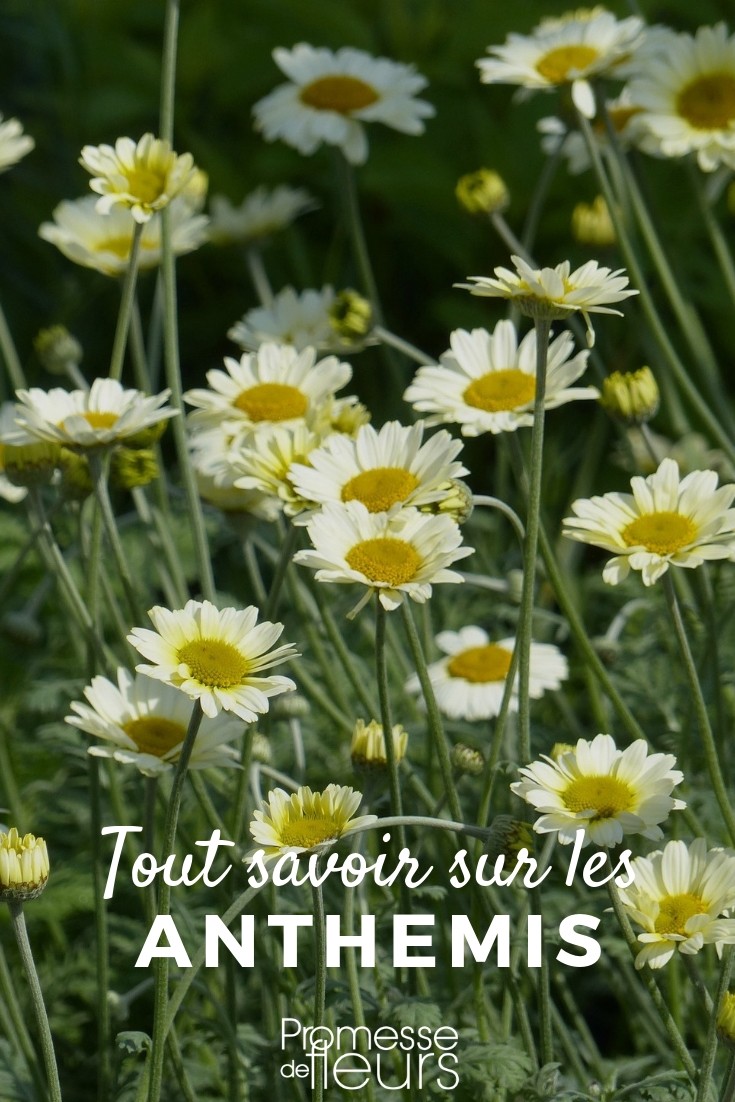































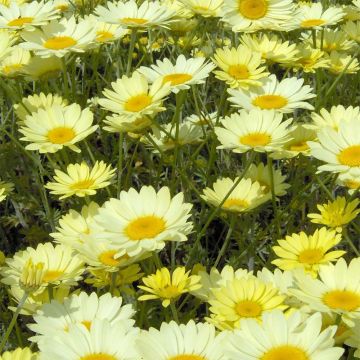


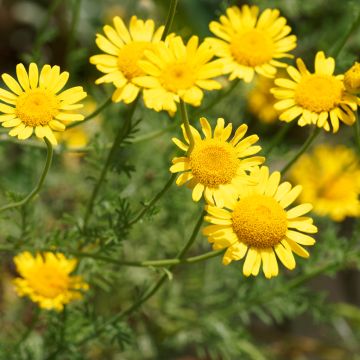

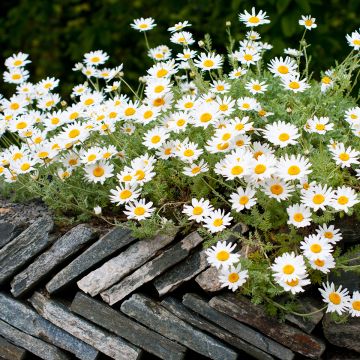


Comments